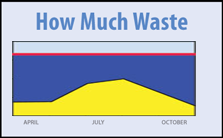Scientists Hope to Improve Drought Tolerance in Plants
A team of scientists has made a significant advance on last year's discovery by Sean Cutler of the University of California-Riverside of pyrabactin, a synthetic chemical that mimics a naturally produced stress hormone in plants to help them cope with drought conditions.
Led by researchers at the Medical College of Wisconsin, the scientists reported in Nature Structural and Molecular Biology that by understanding how pyrabactin works, other more effective chemicals for bringing drought-resistance to plants can be developed more readily.
Plants naturally produce a stress hormone, abscisic acid (ABA), in modest amounts to help them survive drought by inhibiting growth. ABA has already been commercialized for agriculture use. But it has at least two disadvantages: It is light sensitive and costly to make.
Pyrabactin, on the other hand, is relatively inexpensive, easy to make, and is not sensitive to light. But its drawback is that, unlike ABA, it does not turn on all the 'receptors' in the plant that need to be activated for drought-tolerance to fully take hold.
Improving the drought-resistance of plants is an important step in reducing the overall water requirement of crops in both the urban and agriculture settings.


